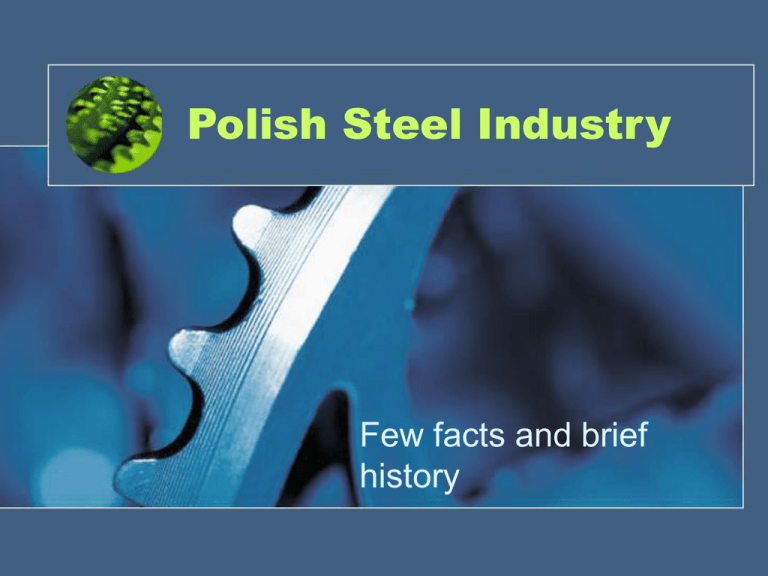Polish Steel Industry
advertisement

Polish Steel Industry Few facts and brief history Why? • Metallurgical industry was mainly developed close to coal mines. And we do not refer here to hard coal, but to coked plant ore, with very high caloric parameters. Steel production requires high temperatures, which are kept by burning coke. The ore, which is a resource used for steel production, was imported from Sweden (Kiruna), Russia and China. The development of this industry in the 20th century was determined by fast development of all machine industries, roads, ship building etc. Currently it should be admitted that there exist a lot of materials replacing pure steel form, e.g. aluminium, duralumin, or materials made of chemical compounds or resin. However, there still exist many fields where steel is indispensable, and that is why steel industry is still developing, e.g. in 2006 world production reached over 1 million tons, which is a 1000% increase within the space of 100 years. Why? Iron ore Pre-1991 map showing Kiruna Mining ore in ,,old times” Where? Katowice Steelworks Sendzimira Steelworks – interior and exterior Pros and cons of public metallurgy industry • Nowadays it is hard to talk about any positive aspects of public metallurgy industry, due to the fact that this kind of ownership is slowly disappearing in our country as well. For example, National Treasury sold recently 27% of CMC Zawiercie Company’s capital, which is the third biggest steel producer in Poland. Earlier in the year 2003, Ministry of Economy sold 71% of stocks of previous Huta Zawiercie to the private Swiss firm, which caused National Treasury to lose its control package. As can be seen, the continuous privatization of this sector takes place in Poland. What is more, Ministry decided to support financially only 6 out of total 40 public ironworks and that will make their managers look for other sources of money. +Better possibility of controlling iron production rate during state of national emergency - Public companies easily fall into debt - Inefficient, cause loss of tax-payers money Pros and cons of public metallurgy industry Polish mine Miners during a short break Why did some countries return this industry to the private sector? • The major reasons are definitely minuses of public ownership, which were mentioned previously. In Poland public management is usually highly incompetent and that causes big debts in companies. Later they can be only saved by large sums provided by private investors, who will simply pay the loan-holders. Moreover, business-people can find clients more easily, introduce higher salaries and in that way employ better-qualified staff, which improves both production rate and quality followed by higher sales. The state itself cannot afford such policy due to the fact that extra financial support of one sector would naturally mean less money for another, whereas a better earning business-person simply pays higher taxes. In that way National Treasury gets benefits from private ironworks without taking the responsibility of its loses or other economically dangerous issues. • To sum up, steel production and coal mining rates are no longer the measures of country’s level of industrial development and they are no more vital to a state’s economical security. Other major questions Is there still government intervention? • Despite previously mentioned matters government intervention unfortunately still exists. As it was mentioned at the beginning, Minister of Economy promised in his official statement from 07.03.2006 to financially support six steel companies. Such steps taken by authorities have their source in the privileged workers position in Polish People’s Republic. Because of that we still have a strong lobby (in mining industry as well) which forces government to pay for companies in debt and to postpone their privatization. It is a pity that most of the society does not understand that process. Fortunately, states interventionism takes only form of donations. What form does it take? • Nowadays steel industry is being restructured, so we witness continuous decrease in employment. This fact is connected with the fast development of our economy in which services are taking the dominating position. The decline [or rise] of steel / coal industries - considering output trends, employment and trade patterns in these industries. • In the coming years, steel products will remain in high demand both on the external and internal markets; for example they will be needed in car, building and electric industries. Impact on economy • • • Katowice Steelworks in Silesia and Sendzimira Steelworks in Krakow were always important centres of steel production because of their location and great production potential. During the socialist realism period they used to be a model example of Polish technical thought and the symbol of Poland’s position in Europe. They were in financial difficulties from the eighties to the nineties, and privatisation in 2004 enabled further development of both steelworks. Steel demands have been challenging and changing with the times, so steelworks had to adapt to those modifications. Production of new types of steel, technological regime and intensive competition in the whole Europe forced new owners to modernize the production and improve the quality of produced steel. Actually steel production is on the increase, and the odds are that this trend will continue. Katowice and Sendzimina Steelworks (now both owned by Mittal Steel) are still strong points of European steel production and are numbered among the biggest industrial centres. They employ over 20 000 people, plus over 100 000 employees in cooperation. Steel production is still profitable mainly because of great market demand, and the fact that raw materials from carbon and iron ores are still quite easily available.







